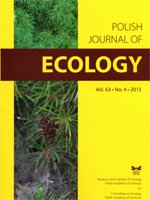Natural river-floodplain systems are heterogenous mosaics of lotic and lentic habitats subjected to dynamic temporal changes connected with hydrological regime, which promote high biological diversity. Mollusc assemblages of three habitat types within 10 km section of the lower course of the Liwiec River (East Poland) — the main river channel (MC), the secondary channel (SC) and remnants of the former river channel (FC), were compared to find if they were structured by heterogeneity resulting from hydrological connectivity and disturbance intensity related to it. The influence of selected qualitative environmental variables was also analysed. The investigations were carried out at 19 sites during late spring and late summer in the years 2012–2014, molluscs were sampled from approximately 1 m2 of the bottom with a hand net, and from macrophytes with a frame. Rich aquatic malacofauna (36 species including 22 gastropods and 14 bivalves) was found within the study area including three species of special interest: Anisus vorticulus (Troschel), Unio crassus Phillipsson and Anodonta cygnea (L.). Bivalves Sphaerium corneum (L.) and Pisidium spp dominated within MC, in SC a few common and ubiquitous species (mainly snails) prevailed, pulmonate snails and some small bivalves of the genus Pisidium were the most numerous molluscs within FC. Principal Component Analysis revealed that current velocity, channel width, bottom sediments and macrophyte abundance were important environmental factors structuring mollusc assemblages. Considerable variation in species composition (β diversity), especially between the main river channel and two other habitat types (β2) was found. The highest values of mean species richness, Shannon true diversity and Shannon index found in the secondary channel were in accordance with intermediate disturbance hypothesis.
How to translate text using browser tools
1 December 2015
Diversity of Aquatic Molluscs in a Heterogenous Section of a Medium-Sized Lowland River-Floodplain System: An Example of Intermediate Disturbance Hypothesis
Ewa Jurkiewicz-Karnkowska
ACCESS THE FULL ARTICLE

Polish Journal of Ecology
Vol. 63 • No. 4
December 2015
Vol. 63 • No. 4
December 2015
Anisus vorticulus (Troschel)
aquatic molluscs
diversity
fresh waters
Liwiec River
spatial heterogeneity
Unio crassus Phillipsson




